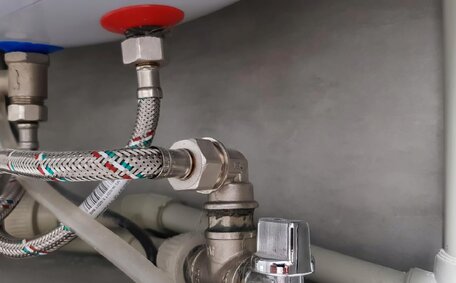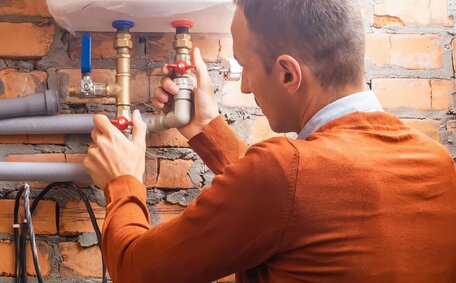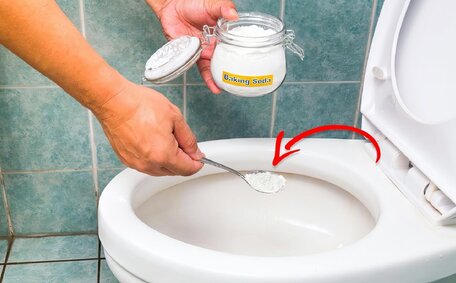Implementing a Regular Inspection Schedule
Set a routine inspection for your hot water system every 3-6 months to proactively identify and resolve minor issues. Here are some key heat pump hot water maintenance tips and things to check:
- Do a visual check of all pipes, valves, the hot water tank, and additional components. Look for corrosion, leaks, or water damage.
- Ensure temperature and pressure relief valves are unobstructed and drain lines are clear.
- Test that valves open and close properly. Replace any worn washers or gaskets.
- Monitor water temperature to ensure it remains between 50-60°C to prevent legionella bacteria growth, thus safeguarding water quality.
- Check the sacrificial anode rod every 2 years and replace if worn.
- For pump hot water and solar hot water systems, ensure the solar water collector, gauges, and pumps are inspected during routine checks.
- Maintain detailed records of inspections for future reference and comparison.
Regular inspections and maintenance extend the lifespan of hot water systems, particularly gas models, by securing a reliable water supply and enabling early issue detection, preventing costly emergency repairs. Act promptly by contacting a licensed plumber to address any issues beyond your capability, detected during inspections, and prevent costly repairs.
Monitoring and Adjusting Water Temperature
Proper system maintenance requires regularly checking your hot water system’s temperature to ensure both efficiency and safety. The ideal temperature range for hot water use is 50-60°C. Temperatures below 50°C in your hot water unit can allow dangerous Legionella bacteria to multiply, while water hotter than 60°C wastes energy and increases the risk of scalding.
To verify your water heater’s temperature is within the ideal range, run a hot tap and use a thermometer to measure the water.
Should the temperature stray from the 50-60°C range, consider adjusting electric hot water systems.
We recommend testing water temperatures every 3 months when you do your routine inspections. Maintaining the ideal 50-60°C range protects your household from potential issues early and ensures safe, efficient water heating.
Testing Pressure Relief Valves
Regularly test pressure relief valves, which are crucial for managing excess pressure and ensuring the longevity of your hot water system, as part of your water heater maintenance routine.
This involves manually operating the lever or button on your water system to ensure water flows freely from the attached drain pipe.
Check your pressure relief valves biannually to verify their proper function.
Take care when testing relief valves as the discharged water service will be hot. Wear protective equipment and have a bucket ready to catch water. Turn off the heat source first and allow the system to cool slightly before testing.
If uncertain about testing procedures or safety, especially when examining critical components like the heat exchanger, contact a licensed plumber for inspections. Keep in mind that as storage water heaters age over 8-15 years, valves wear out faster from mineral buildup and require more frequent testing or replacement.
Maintaining Adequate Clearance and Ventilation
Ensuring enough clearance around hot water systems is crucial to prevent overheating and damage. Adhere to the AS/NZS 5601.1 2013 regulations for minimum clearances to minimise safety risks for gas storage systems:
- 300mm clearance from the flue terminal
- 500mm clearance to any openings into the building
- 300mm side and rear clearance to combustible materials
For tank-based storage hot water systems, maintain 500mm clearance at the front and sides for accessibility and ensure proper ventilation. Refer to the manufacturer’s guidelines since requirements vary by system type and size.
Signs of insufficient clearance or ventilation, which can affect performance and the life your hot water system, include abnormal noise from the unit or a decrease in hot water production. Dust buildup, corrosion and leaks can also indicate airflow blockages or proximity issues accelerating wear.
Ensuring adequate clearance and ventilation achieves optimal performance and efficiency while extending the operating life of your hot water system. Position units correctly during installation and maintain accessibility for servicing. If you suspect issues with clearance or ventilation, promptly consult a licensed plumber.
Scheduling Professional Maintenance
Schedule professional servicing of your hot water system every 1-2 years by a qualified plumber to ensure optimal performance over the years.
Professionals can determine if the size your hot water systems can align with your hot water needs, guaranteeing a consistent supply hot water during regular servicing. They can perform tasks like flushing sediment buildup from pipes, adjusting thermostats and valves, replacing worn parts, and testing relief valves using specialised equipment.
Preventive maintenance not only improves efficiency and lowers energy costs but also ensures you have the most suitable hot water system for your needs, while also diminishing greenhouse gas emissions. It also extends lifespan by addressing problems before failure, avoiding expensive emergency repairs.
North Epping Plumbing, servicing areas including the Gold Coast and the Central Coast, are licensed professionals capable of maintaining all hot water system brands. We use the latest methods and technology to keep your system running like new.
Schedule periodic professional hot water service maintenance with us to service the water system your home and enjoy safe, peak performing hot water for your entire household for years to come as well as securing the system and your home.
Conducting Valve Maintenance and Replacement
Valves play a crucial role in regulating temperature and pressure in your gas water heating system. If water flow drips continuously after testing, the TPR valve requires replacing.
Regularly inspect your hot water heater’s valves for wear, corrosion, leaks, and operational issues. For water heater maintenance, temperature and pressure relief (TPR) valves should be tested every 6 months by running water through the drain valve to ensure adequate flow.
Operate main shutoff valves, tempering valve components, and isolation valves to ensure they function correctly. Check valve handles and stems for mineral deposits or corrosion, replacing any worn washers.
Valves in storage water heaters, which have a lifespan of 8-15 years, need to be replaced every few years due to age and wear regardless of testing.
Replace worn valves to avoid leaks and guarantee the effective operation of safety mechanisms in your system. Partnering with a reputable plumbing company like North Epping Plumbing provides peace of mind, as our licenced technicians have the expertise to conduct testing and identify issues to avoid costly emergency repairs down the line.
Understanding System Placement Considerations
The placement of your hot water system can greatly impact performance and longevity. Optimal positioning provides proper ventilation, accessibility for maintenance, efficient heat transfer and protection from weather elements, which can lead to a longer-lasting system.
Install gas and electric hot water units where there is adequate airflow, adhering to the AS/NZS 5601.1 clearance guidelines. Exposure to direct sunlight should be avoided in warmer climates to prevent overheating. Outdoor units require weatherproof enclosures with adequate airflow.
Strategically place your tanks to simplify anode rod removal, reducing maintenance effort and boosting system longevity. Group all components tidily during installations for convenience.
Consider heat loss in pipes by placing systems close to frequently used outlets. However, avoid hot water lines running through uninsulated spaces. Position away from air conditioners which can draught cold air over pipes.
Consult a professional during installation for optimal system placement. Factoring in ventilation, access, heat efficiency and weather protection extends a system’s lifespan and performance.
Identifying the Age and Type of Your System
Being aware of your hot water system’s age and type is essential for proper maintenance and peak performance. Tank-based storage systems typically last 8-15 years, but all systems, particularly older and continuous flow models, demand diligent monitoring for signs of wear to anticipate potential failures.
The main system types are storage, tankless, heat pump, and solar. Heat pumps use air and electricity to heat water.
Instant electric models are a popular choice for on-demand hot water heating, eliminating the need for a storage tank.
Identifying your system type, including the hot water storage configuration, sets expectations for maintenance needs, energy efficiency, and impacts the lifespan of your hot water unit. Storage tanks require anode rod testing while tankless models need descaling. Understanding age also helps budget for upgrades or replacement approaching end-of-life at 8-15 years.
Consult installation paperwork if available to verify system details. Otherwise, A licenced plumber can help inspect and identify the make, model, type and age. This allows tailored maintenance for optimal safety and performance throughout your system’s lifecycle.
Recognizing Symptoms Needing System Replacement
There are several warning signs indicating your hot water system requires replacement rather than maintenance:
- Consistent lack of hot water even after attempting fixes like adjusting thermostats
- Visible leaks, drips or puddles under the unit
- Loud noises such as banging or rumbling
- Discoloured water with sediment or a foul odour
- Low water pressure or sudden changes in temperature
- Frequent activation of the pressure relief valve
Should you observe these symptoms, contact North Epping Plumbing for an immediate evaluation and potential installation of a new hot water system. Our licenced technicians can diagnose issues and advise if your system requires replacing due to age or wear after its typical 8-15 year lifespan.
Contact our team at [email protected] or call 1300 349 338 for guidance on replacement options when maintenance is no longer viable.






